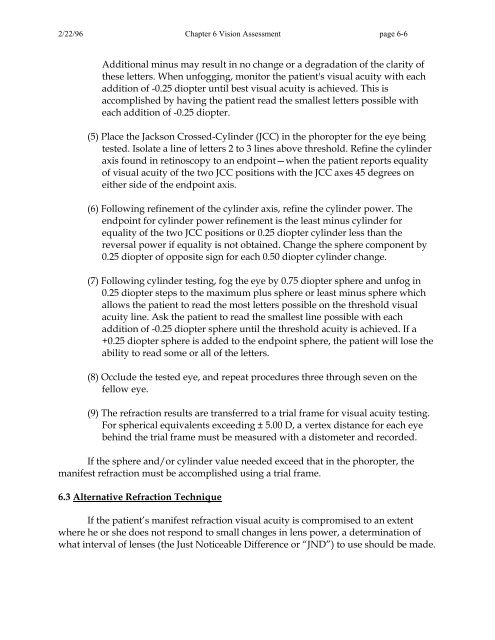OM t of c.iii - Vision Research Coordinating Center - Washington ...
OM t of c.iii - Vision Research Coordinating Center - Washington ...
OM t of c.iii - Vision Research Coordinating Center - Washington ...
Create successful ePaper yourself
Turn your PDF publications into a flip-book with our unique Google optimized e-Paper software.
2/22/96 Chapter 6 <strong>Vision</strong> Assessment page 6-6<br />
Additional minus may result in no change or a degradation <strong>of</strong> the clarity <strong>of</strong><br />
these letters. When unfogging, monitor the patient's visual acuity with each<br />
addition <strong>of</strong> -0.25 diopter until best visual acuity is achieved. This is<br />
accomplished by having the patient read the smallest letters possible with<br />
each addition <strong>of</strong> -0.25 diopter.<br />
(5) Place the Jackson Crossed-Cylinder (JCC) in the phoropter for the eye being<br />
tested. Isolate a line <strong>of</strong> letters 2 to 3 lines above threshold. Refine the cylinder<br />
axis found in retinoscopy to an endpoint—when the patient reports equality<br />
<strong>of</strong> visual acuity <strong>of</strong> the two JCC positions with the JCC axes 45 degrees on<br />
either side <strong>of</strong> the endpoint axis.<br />
(6) Following refinement <strong>of</strong> the cylinder axis, refine the cylinder power. The<br />
endpoint for cylinder power refinement is the least minus cylinder for<br />
equality <strong>of</strong> the two JCC positions or 0.25 diopter cylinder less than the<br />
reversal power if equality is not obtained. Change the sphere component by<br />
0.25 diopter <strong>of</strong> opposite sign for each 0.50 diopter cylinder change.<br />
(7) Following cylinder testing, fog the eye by 0.75 diopter sphere and unfog in<br />
0.25 diopter steps to the maximum plus sphere or least minus sphere which<br />
allows the patient to read the most letters possible on the threshold visual<br />
acuity line. Ask the patient to read the smallest line possible with each<br />
addition <strong>of</strong> -0.25 diopter sphere until the threshold acuity is achieved. If a<br />
+0.25 diopter sphere is added to the endpoint sphere, the patient will lose the<br />
ability to read some or all <strong>of</strong> the letters.<br />
(8) Occlude the tested eye, and repeat procedures three through seven on the<br />
fellow eye.<br />
(9) The refraction results are transferred to a trial frame for visual acuity testing.<br />
For spherical equivalents exceeding ± 5.00 D, a vertex distance for each eye<br />
behind the trial frame must be measured with a distometer and recorded.<br />
If the sphere and/or cylinder value needed exceed that in the phoropter, the<br />
manifest refraction must be accomplished using a trial frame.<br />
6.3 Alternative Refraction Technique<br />
If the patient’s manifest refraction visual acuity is compromised to an extent<br />
where he or she does not respond to small changes in lens power, a determination <strong>of</strong><br />
what interval <strong>of</strong> lenses (the Just Noticeable Difference or “JND”) to use should be made.
















